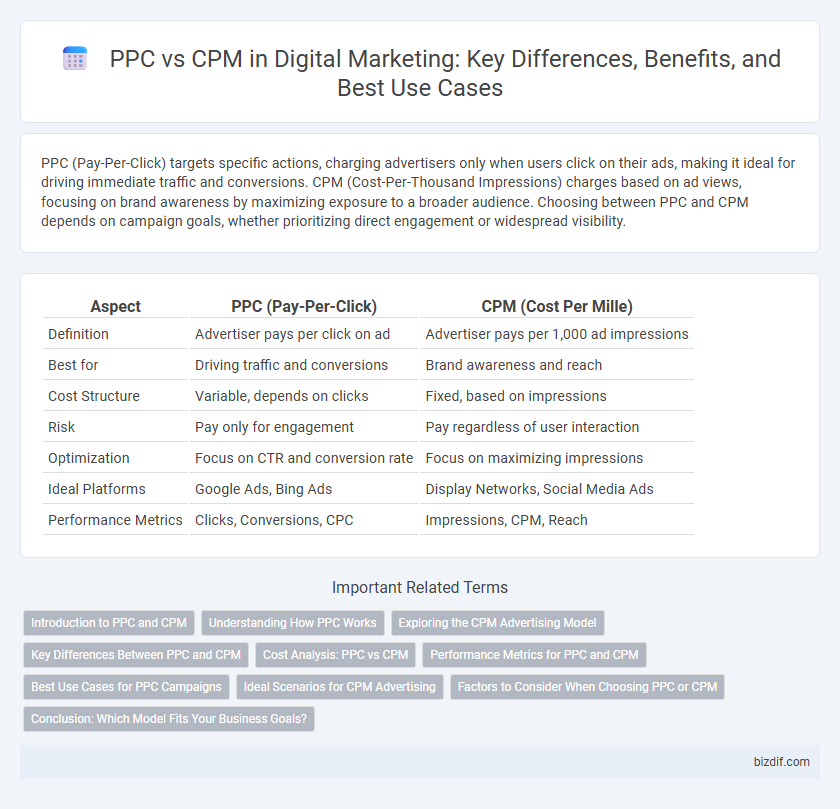PPC (Pay-Per-Click) targets specific actions, charging advertisers only when users click on their ads, making it ideal for driving immediate traffic and conversions. CPM (Cost-Per-Thousand Impressions) charges based on ad views, focusing on brand awareness by maximizing exposure to a broader audience. Choosing between PPC and CPM depends on campaign goals, whether prioritizing direct engagement or widespread visibility.
Table of Comparison
| Aspect | PPC (Pay-Per-Click) | CPM (Cost Per Mille) |
|---|---|---|
| Definition | Advertiser pays per click on ad | Advertiser pays per 1,000 ad impressions |
| Best for | Driving traffic and conversions | Brand awareness and reach |
| Cost Structure | Variable, depends on clicks | Fixed, based on impressions |
| Risk | Pay only for engagement | Pay regardless of user interaction |
| Optimization | Focus on CTR and conversion rate | Focus on maximizing impressions |
| Ideal Platforms | Google Ads, Bing Ads | Display Networks, Social Media Ads |
| Performance Metrics | Clicks, Conversions, CPC | Impressions, CPM, Reach |
Introduction to PPC and CPM
Pay-Per-Click (PPC) is a digital marketing model where advertisers pay only when users click on their ads, driving targeted traffic and measurable ROI. Cost Per Mille (CPM) charges advertisers based on every thousand impressions, focusing on brand visibility rather than direct engagement. Both PPC and CPM are critical strategies for online advertising campaigns, with PPC emphasizing performance and CPM optimizing for exposure.
Understanding How PPC Works
Pay-per-click (PPC) advertising charges advertisers each time a user clicks on their ad, providing precise control over budget and targeting. PPC campaigns rely on keyword bidding, ad relevance, and quality score to determine ad placement and cost per click (CPC). This model ensures advertisers pay only for actual user engagement, making it highly efficient for driving targeted traffic and measurable conversions.
Exploring the CPM Advertising Model
The CPM (Cost Per Mille) advertising model charges advertisers based on every 1,000 impressions, making it ideal for brand awareness campaigns targeting broad audiences. Unlike PPC (Pay Per Click), CPM focuses on visibility rather than direct user interactions, optimizing ad spend for maximum exposure across platforms like Google Display Network and Facebook Ads. Marketers leverage CPM to increase reach and frequency, especially in campaigns where impressions drive results more effectively than clicks.
Key Differences Between PPC and CPM
PPC (Pay-Per-Click) charges advertisers each time a user clicks on their ad, focusing on direct engagement and driving immediate traffic. CPM (Cost-Per-Thousand Impressions) bills based on every thousand ad impressions, emphasizing brand visibility and reach rather than direct clicks. Key differences include performance metrics, cost structure, and campaign objectives, where PPC targets conversions and CPM optimizes for awareness.
Cost Analysis: PPC vs CPM
PPC (Pay-Per-Click) charges advertisers based on actual clicks, making it cost-effective for campaigns focused on direct response and lead generation. CPM (Cost-Per-Mille) bills per thousand impressions, offering better value for brand awareness and reach-driven strategies where exposure matters more than immediate actions. Analyzing cost efficiency depends on campaign goals: PPC optimizes budget through measurable engagement, while CPM is advantageous for maximizing visibility at a fixed cost.
Performance Metrics for PPC and CPM
PPC (Pay-Per-Click) performance metrics primarily track click-through rates (CTR), cost per click (CPC), and conversion rates to measure direct user engagement and return on investment. CPM (Cost Per Mille) metrics emphasize impressions, reach, and brand awareness rather than immediate actions, focusing on cost efficiency per thousand views to gauge audience exposure. Comparing CTR and conversion data for PPC with CPM's impression and reach statistics provides critical insights for optimizing digital marketing campaigns based on specific campaign objectives.
Best Use Cases for PPC Campaigns
PPC campaigns are highly effective for driving immediate traffic and capturing high-intent audiences, making them ideal for lead generation, product launches, and direct sales. They offer precise budget control and detailed performance tracking, allowing marketers to optimize campaigns based on click-through rates and conversion data. PPC is best suited for businesses aiming to maximize return on investment through targeted keyword bidding in search engines and social media platforms.
Ideal Scenarios for CPM Advertising
CPM advertising is ideal for brand awareness campaigns where the goal is to reach a large audience with high visibility at a predictable cost per thousand impressions. This model benefits businesses launching new products or targeting broad demographics to maximize exposure without focusing on immediate clicks or conversions. Companies with substantial budgets aiming to build long-term brand recognition in competitive markets often prioritize CPM over PPC to enhance market presence efficiently.
Factors to Consider When Choosing PPC or CPM
When choosing between PPC (Pay-Per-Click) and CPM (Cost-Per-Mille) in digital marketing, consider campaign goals such as brand awareness or direct conversions. PPC offers precise targeting and cost efficiency for performance-driven campaigns, while CPM is ideal for maximizing impressions and reaching a broad audience. Budget allocation, target audience behavior, and the nature of the product or service also play critical roles in selecting the appropriate bidding model.
Conclusion: Which Model Fits Your Business Goals?
Choosing between PPC and CPM depends on your business objectives; PPC is ideal for performance-driven campaigns aiming at direct conversions and maximizing ROI, while CPM suits brand awareness strategies focused on reaching a broad audience and increasing visibility. Analyzing metrics such as click-through rates (CTR) and cost-per-acquisition (CPA) can guide optimization based on whether immediate actions or impression volume align better with your marketing goals. Businesses prioritizing measurable customer actions should leverage PPC, whereas those seeking mass exposure benefit more from CPM advertising models.
PPC vs CPM Infographic

 bizdif.com
bizdif.com